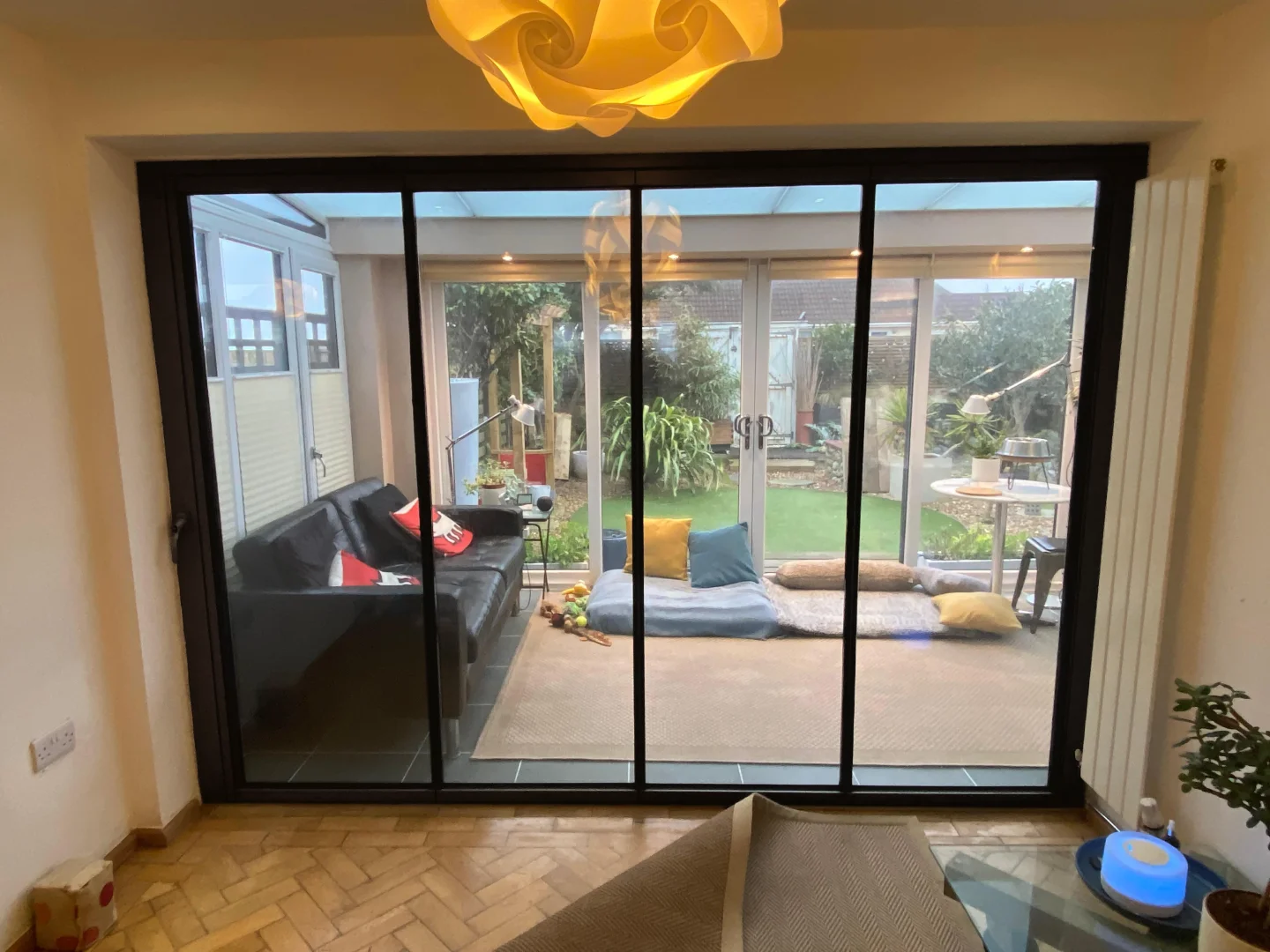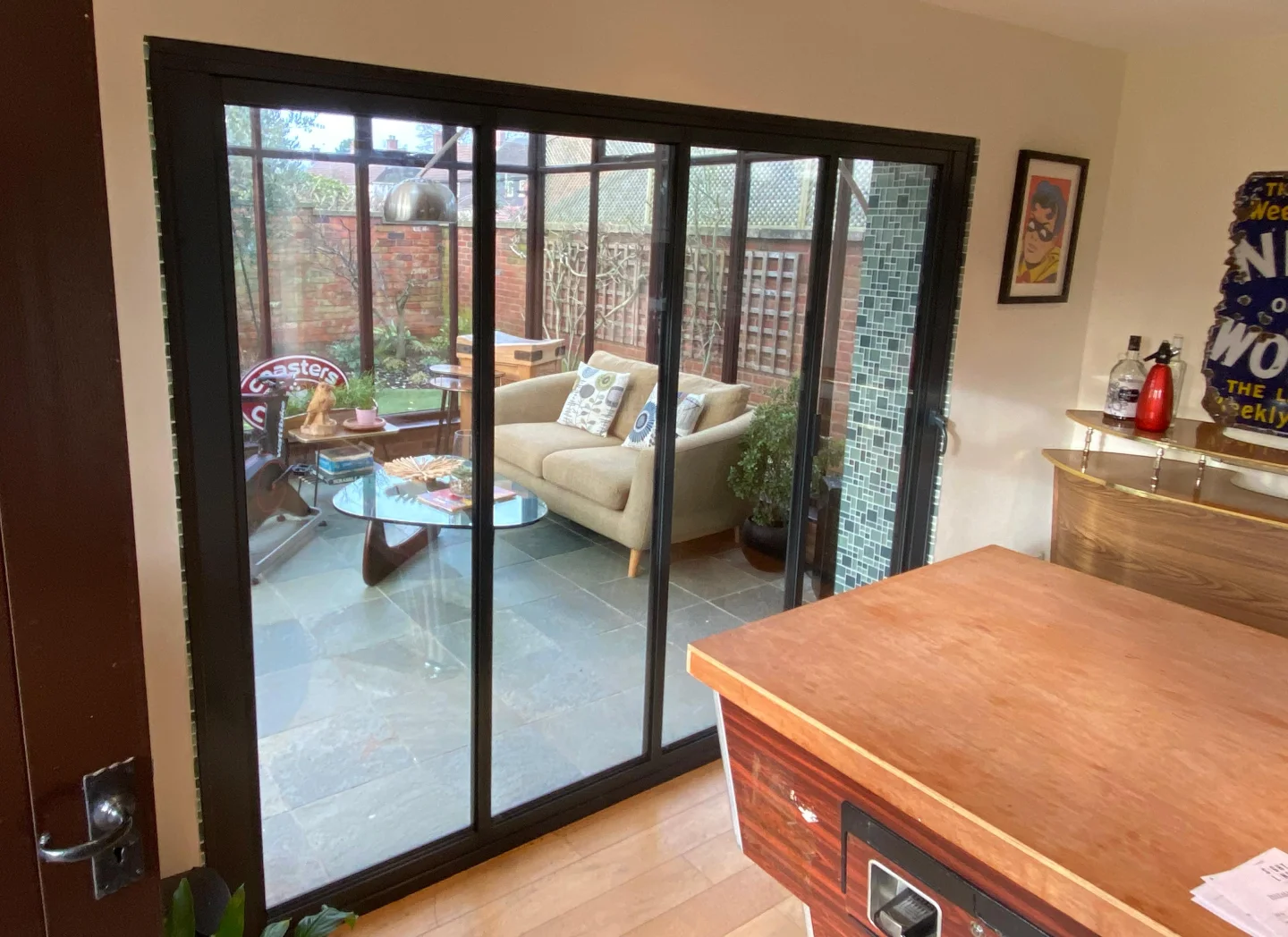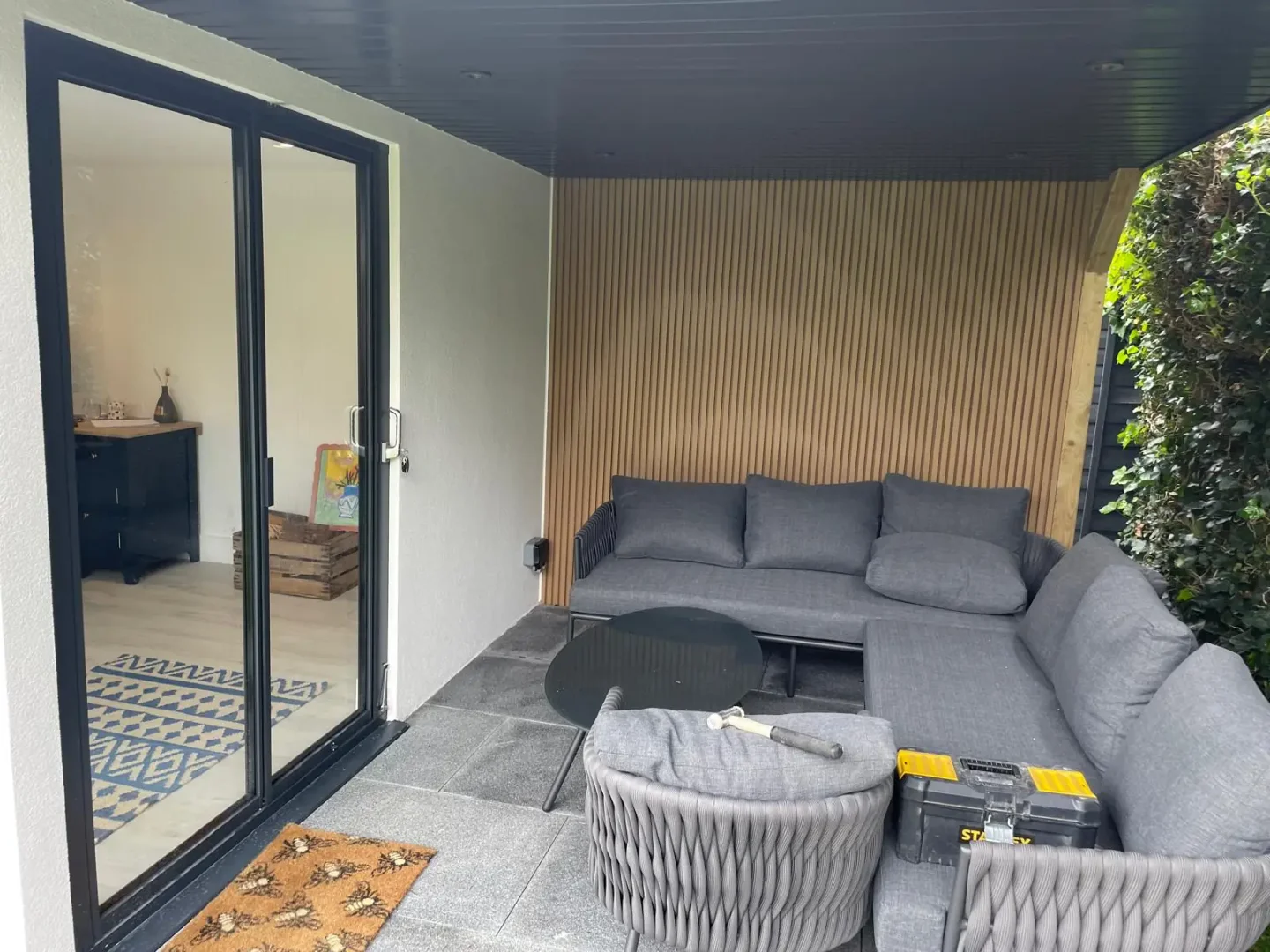Guide to Black Sliding Internal Doors: Making Spaces Work
Table of Contents

Choosing Black Sliding Internal Doors
Modern British homes increasingly feature black sliding internal doors as striking room dividers and space-making features. These doors blend practical space management with bold design statements, whether installed in period properties or new builds.
Different Types of Black Sliding Door Systems
Single-panel black sliding internal doors suit narrow doorways between smaller rooms, sliding neatly along one wall. Double-panel systems create wider openings, with each panel gliding in opposite directions to reveal an expanse of up to several metres. Pocket doors – which slide completely into the wall cavity – offer a particularly clean look, while bypass systems allow panels to overlap, making them ideal for wardrobes and storage areas.
Black framed doors vary substantially in their construction, from slim-profile aluminium frames to chunky industrial-style steel. Track-mounted systems hang from the top of the doorway, supporting door weights between 45 and 180 kg depending on the mechanism chosen. Floor-guided systems add stability but require a discreet channel in the floor surface.
Glass and Metal Options
Material Selection Guide
Black aluminium sliding internal doors dominate the market due to their durability and clean lines. Powder-coated aluminium frames resist scratches and maintain their colour, while steel frames suit industrial schemes but carry a higher price tag. Both materials pair beautifully with architectural glass, from clear panels that allow for plenty of light flow to frosted options for privacy.
The contrast between black frames and glass creates visual interest without overwhelming the space. Toughened safety glass comes standard in most designs, while laminated acoustic glass helps reduce noise between rooms. Some manufacturers offer textured or patterned glass options that complement contemporary and traditional interiors alike.

Frame Styles and Hardware
Flush handles maintain clean lines, while statement handles in matching black finishes add visual interest. The tracking system – typically mounted at the top of the door – should operate smoothly and quietly, with high-quality rollers ensuring reliable daily use.
Frame profiles range from ultra-slim designs that increase glass area to broader industrial-style sections that make a stronger statement. Soft-close mechanisms prevent slamming and protect the glass, while brush seals reduce drafts without compromising the smooth operation of the door.
Each component requires careful consideration, from the frame joints to the guide system. Quality brackets and fixings ensure stability, while properly engineered tracks prevent the door from jumping or sticking. Premium systems often feature adjustable rollers, allowing fine-tuning of the door position even after installation.
Black sliding internal doors need precise fitting to work properly. The structural opening must be perfectly level and plumb, with adequate support above for track-mounted systems.
Black Sliding Internal Doors in Modern Spaces
Stark lines and bold contrasts define contemporary interior design trends, with black sliding internal doors taking centre stage in modern homes across Britain. These striking features draw the eye while dividing spaces with precision and style.
Minimalist Design Integration
Clean lines and uncluttered spaces gain extra impact from black sliding internal doors. A matte black frame against crisp white walls creates sharp definition without overwhelming the space. Natural light plays across glass panels throughout the day, casting ever-changing shadows that add depth to minimal interiors.
The simplicity of modern minimalism requires careful material selection. Black internal doors in slender aluminium frames complement this style perfectly, their slim profiles preserving sight lines while providing necessary room division. Cool greys and warm whites provide an ideal backdrop, allowing the doors to stand as architectural features in their own right.
Industrial Style Applications
Raw materials and exposed structures find their perfect match in black sliding internal doors. In urban lofts and converted warehouses, these doors echo industrial heritage while providing practical space division. Steel frames with generous proportions suit this aesthetic particularly well, especially when paired with bare brick or concrete surfaces.
Full height sliding doors make an especially bold statement in double-height spaces. Their vertical emphasis draws the eye upward, improving the sense of scale in large open areas. When paired with metal staircases or exposed ductwork, black aluminium sliding internal doors reinforce the industrial character of the space.
Material Harmony
Concrete floors and metal finishes work in harmony with dark door frames. The key lies in balancing different surface textures – smooth glass against rough concrete, or brushed metal against glossy black frames. This interplay of materials adds depth to industrial schemes without compromising their essential character.
Statement Pieces in Open Plans
Living space design often calls for flexible boundaries, and black sliding internal doors answer this need with style. They can separate a home office from a dining area or screen a kitchen from view when needed, all while maintaining visual continuity through their glass panels.
Position matters immensely when using doors as focal points. Centring black sliding internal doors on key sight lines creates natural focal points, while asymmetric placement can add dynamic interest to otherwise regular spaces. The doors become architectural elements that shape how people experience and move through the home.
Light plays a big part in making these doors stand out. Directional lighting can cast dramatic shadows from the frame pattern, while back-lighting turns the entire door into a glowing screen at night. These effects change the character of spaces throughout the day, adding layers of interest to modern interiors.
Creating Spaces with Black Sliding Internal Doors
Space division becomes an art form with black sliding internal doors, letting homeowners shape their living areas while preserving openness and flow. These adaptable partitions redefine how rooms connect and separate, making them particularly valuable in modern home renovation projects.

Room Division Techniques
Black sliding internal doors excel at creating distinct zones without permanent walls. A home office emerges from an open-plan living area, or a dining space separates from the kitchen – all while maintaining visual connections through glass panels. The black frames provide definition without the heaviness of solid walls, letting spaces remain light and airy.
Strategic placement of interior partitions determines how people move through and use spaces. Black aluminium sliding internal doors installed at angles or offset from walls create interesting pathways and unexpected sight lines. This approach works especially well in larger rooms where traditional layouts might feel static or predictable.
When positioned thoughtfully, these doors become natural breaking points between activities. A partially open door suggests separation while inviting interaction – perfect for family homes where complete isolation isn’t always desired. The dark frames act as visual anchors, helping to establish clear boundaries even when the doors stand open.
Small Space Tips
Compact Living Strategies
Space saving design reaches new levels with black sliding internal doors in smaller homes. Unlike hinged doors that require swing space, sliding systems operate within their own footprint. This space-efficient operation proves particularly valuable in flats and compact houses where every centimetre counts.
The reflective quality of glass panels in black sliding internal doors helps create an illusion of extra space. Light bounces between rooms even when the doors are closed, while the frames provide structure without bulk. Pocket door systems, which slide completely into wall cavities, offer the ultimate in space efficiency for tight areas.
Smart positioning of sliding door room dividers can make one room serve multiple purposes. A black-framed glass partition might separate a bedroom from a home office during the day, then slide away to create a larger space for evening relaxation. The dark frames provide enough visual weight to suggest separation without creating claustrophobia in small spaces.
Light Flow and Privacy Balance
Natural light penetration remains unrestricted with black sliding internal doors, yet privacy doesn’t suffer. Frosted or patterned glass options maintain light transmission while obscuring direct views. The black frames actually improve privacy by reducing transparency at oblique angles, even with clear glass.
Light management becomes intuitive with these doors. Partial opening allows precise control over light flow between spaces, while the frames themselves cast interesting shadow patterns that change throughout the day. In north-facing rooms, the ability to borrow light from brighter spaces proves invaluable.
The relationship between privacy and openness shifts with different glass treatments. Interior black sliding glass doors might feature graduated opacity – clear at the top for light, frosted below for privacy. This layered approach creates interesting visual effects while serving practical needs.
Managing sound transmission requires careful planning. Double-glazed panels reduce noise transfer, while high-quality track systems eliminate operational noise. Brush seals and magnetic catches help create better acoustic separation when needed, without compromising the smooth gliding action that makes these doors so appealing.
Black sliding internal doors work particularly well in properties with varying privacy needs. A glass partition between living room and kitchen might feature clear panels, while doors leading to private areas use frosted glass. This mixed approach maintains the cohesive look of black frames throughout the house while adapting to different requirements.
Style and Design with Black Sliding Internal Doors
Contemporary spaces gain definition and character from black sliding internal doors, which serve as architectural features in their own right. In modern interior design schemes, these striking elements bridge different styles while maintaining visual coherence.
Period Home Integration
Victorian and Georgian properties present unique opportunities for black sliding internal doors. Original features like ornate cornices and deep skirting boards provide a rich context for modern door systems. The contrast between heritage architecture and sleek black frames creates visual tension that brings life to traditional spaces.
Black glass sliding internal doors work particularly well in period renovations where traditional door openings need widening. The slim sight lines of modern aluminium frames preserve original proportions while providing larger openings between rooms. This approach respects the building’s heritage while improving its utility for modern living.
High ceilings in period homes allow for dramatic door installations. Floor-to-ceiling black sliding internal doors emphasise room height, drawing attention to original architectural features. In homes with grand proportions, double-width doors can span impressive distances without appearing overwhelming.
Contemporary Colour Schemes
Palette Planning
Paint colours play a vital part in how black sliding internal doors sit within contemporary spaces. Deep navy walls create subtle contrast with black frames, while pale greys provide sharp definition. Whites range from bright architectural white to softer shades that complement rather than compete with the doors.
Large aluminium sliding doors in black make powerful statements against feature walls in deep, rich colours. Emerald green, burgundy, or charcoal grey all provide sophisticated backdrops that highlight the geometric precision of black door frames. These strong colours work best when limited to single walls or defined areas.
Natural light changes how black doors appear throughout the day. Morning sun might cast crisp shadows from the frames, while evening light softens their appearance. This interplay of light and shadow adds depth to minimalist aesthetics and rewards thoughtful door positioning.
Natural Material Combinations
Raw materials bring warmth and texture to spaces divided by black sliding internal doors. Wooden flooring – whether original floorboards or modern engineered timber – creates an organic contrast with metal and glass. The combination of materials feels particularly appropriate in contemporary interiors where texture provides visual interest.
Stone surfaces offer another way to complement internal sliding doors. Marble, limestone, or slate each bring distinct characters that work well with black frames. These natural materials share an inherent elegance with well-designed door systems, creating cohesive schemes that avoid feeling contrived.
Black doors establish strong horizontal and vertical lines that can emphasise or contrast with natural materials’ organic patterns. Wood grain, stone veining, and even the texture of exposed brick take on new significance when framed by precise black lines. This interplay between natural and manufactured elements adds sophistication to contemporary spaces.
The weight and substance of natural materials help ground large glass doors in their surroundings. Heavy timber beams or stone floor tiles provide visual anchors for full-height door installations. These material combinations create spaces that feel carefully composed rather than simply assembled.
In kitchens and bathrooms, black aluminium sliding internal doors withstand moisture while complementing popular material choices like porcelain tiles and stone countertops. Their resilient finishes maintain their appearance even in challenging environments, making them practical as well as attractive room dividers.
Practical Aspects of Black Sliding Internal Doors
The technical elements of door installation shape how these striking features perform in daily use. From track systems to sound insulation, each component must work perfectly to ensure smooth operation and lasting satisfaction.

Track Systems and Operation
Black sliding internal doors rely on precision-engineered tracks for reliable movement. Top-hung systems distribute weight through the header beam, requiring sturdy framing above the opening. The track itself contains rolling mechanisms with steel ball bearings that glide silently along aluminium channels.
Different track configurations suit various applications. A single track works for basic room dividers, while double tracks allow doors to stack in parallel.
Internal black sliding doors between a home office and living room might use a bypass system, letting panels overlap for complete closure or partial opening as needed.
Installing tracks demands careful alignment and levelling. Even minor deviations from true can cause doors to drift or stick. Premium systems include adjustable rollers and brackets that allow fine-tuning after installation. This adjustability proves invaluable as buildings settle and materials respond to seasonal changes.
Frame Thickness and Door Weight
Load Calculations
Glass thickness and frame design determine the overall weight of black sliding internal doors. A typical panel measuring 2.5 metres high might weigh between 45 and 90 kilograms, depending on glass specification and frame construction. Larger installations, like sliding dining room doors spanning wide openings, require additional support and heavier-duty hardware.
Black aluminium sliding internal doors offer an ideal balance of strength and visual lightness. Their frames provide adequate rigidity while maintaining slim sight lines that homeowners prefer. Steel alternatives weigh more but suit industrial-style installations where robust appearance matches practical requirements.
Panel size limits vary by system type and installation method. Most manufacturers specify maximum heights and widths based on extensive testing. Exceeding these limits risks compromising operation and safety, particularly in applications requiring frequent movement.
Sound Control Options
Acoustic performance matters greatly in modern homes where black sliding internal doors separate living spaces from work areas. Double-glazed panels with varying glass thicknesses reduce sound transmission more effectively than single glazing. The air gap between panes breaks sound paths while maintaining visual connections.
Quality seals around door edges improve acoustic isolation. Brush strips and rubber gaskets fill gaps in the closed position without impeding movement. These seals require precise installation and occasional adjustment to maintain their effectiveness over time.
Sound reduction varies with door configuration and glass specification. A basic system might reduce noise by 25 decibels, while advanced acoustic glass packages achieve higher attenuation. The frame design itself contributes to sound control, with multi-chamber profiles performing better than simple sections.
Black sliding internal doors installed between noise-sensitive spaces need particular attention to detail. Flush thresholds and ceiling tracks should include acoustic breaks to prevent sound flanking around the door system. Even small gaps can compromise overall performance.
Commercial-grade sound sealing often inspires residential installations of black sliding interior doors. Meeting room technology adapted for home use provides proven solutions for noise control. These systems cost more initially but deliver lasting acoustic benefits that justify the investment.
Guide channels in the floor help stabilise large door panels without compromising thresholds. Recessed tracks sit flush with flooring, while surface-mounted guides offer simpler installation. Each approach has merit depending on floor construction and usage patterns.
We’d Love to Help You
Vision Glass Doors is a designer, manufacturer, and installer of premium door systems. We are a family run business with over 20 years’ experience and 5,000 installations across the UK.
Our leading range of door systems include Ultra Slim – Slide and Turn Doors, Slimline Sliding Patio Doors and Frameless Glass Doors. Suitable for various internal and external applications, they are applicable to residential and commercial projects.
Click Quick Quote Online for a free quotation within 24 hours. Alternatively, call or email us on 01582 492730 or at info@visionglassdoors.co.uk.

